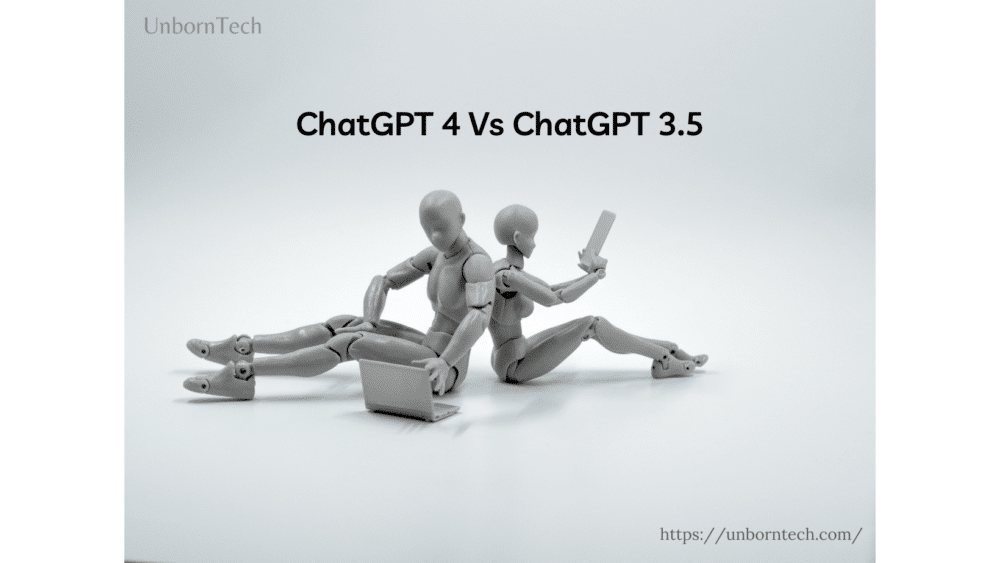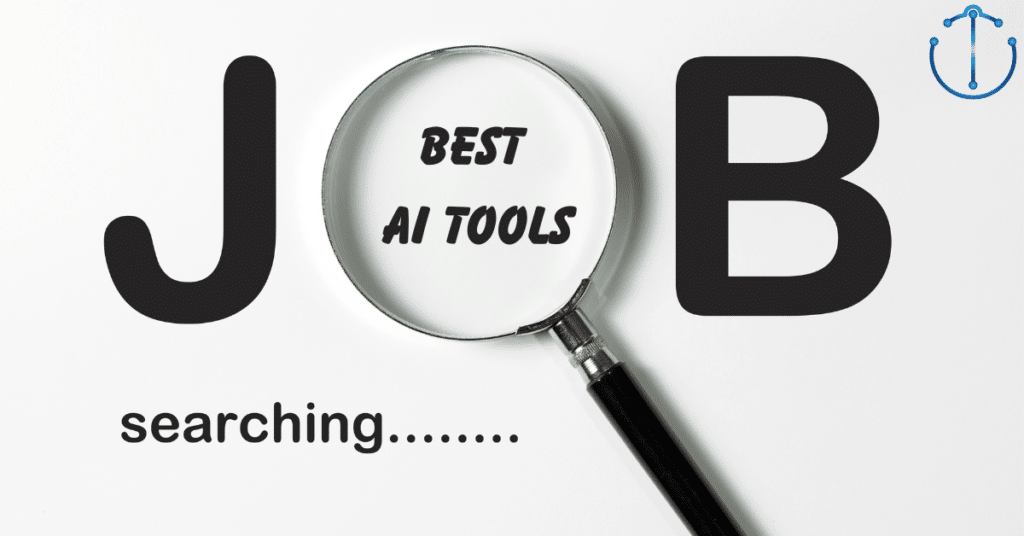OpenAI has just released GPT-4, the newest version of its cutting-edge artificial intelligence language model that powers ChatGPT. It was launched on March 14, 2023, and it is currently the most up-to-date version of the software. With GPT-4, OpenAI has taken a big step forward, making it the most powerful and advanced model yet.
However, the question remains: how does GPT-4 differ from its predecessor, ChatGPT-3.5?
In this article, we will explore ten major differences between GPT-4 and ChatGPT 3.5, and discuss how GPT-4 is more intelligent than its predecessors. As we explore the differences between ChatGPT-4 and ChatGPT-3.5, we will also take a closer look at some live examples and information on who has access to this cutting-edge language model.
Table of Contents
How ChatGPT-4 differs from ChatGPT-3.5?
Even though there are plenty of differences between the two models from multiple perspectives, here are the top 10 differences that one should know before investing in ChatGPT 4.
1 – Multimodality – Accept Images as input
The most noteworthy difference between these two models is their ability to accept input in different modalities. While GPT-3.5 was limited to text prompts, GPT-4 is multimodal and can accept both text and visual inputs. This means that GPT-4 can process images and other visual data to find relevant information.
GPT-4’s multimodal feature has the potential to revolutionize AI chatbots like ChatGPT. It could enable chatbots to respond with videos or images, making interactions more engaging and improving the user experience. Additionally, GPT-4 can summarize support calls with text after listening to recordings, which could save thousands of hours of work.
While GPT-4’s multimodality feature is a significant improvement, it is still in development and has its limitations. However, OpenAI is continuously working to improve the chatbot’s reliability and expand its capabilities. Overall, GPT-4’s ability to understand multiple modalities of information makes it a game-changer for AI chatbots and other related fields.
2 – More Accurate and Factual
GPT-4 offers significant improvements over its predecessor, GPT-3.5, particularly in terms of accuracy and factual information. Despite still having a tendency to produce nonsensical and untruthful information, GPT-4 is 19% – 29% less likely to “AI hallucinate” than GPT-3.5. Additionally, GPT-4 is 40 percent more likely to produce factual responses and 82% less likely to respond to requests for content that isn’t allowed. These improvements have significant implications for the reliability of information on the internet and can increase user trust in applications such as search engines.
However, GPT-4 can still generate biased, false, and hateful text, and it is not entirely foolproof.
3 – Less Likely to Get Tricked
One of the biggest criticisms of previous AI chatbots has been their vulnerability to being tricked or misled. However, GPT-4 claims to have significantly improved on this issue. Thanks to its extensive training on malicious prompts, the latest model is more difficult to fool and better at giving out factual information. OpenAI has also applied lessons learned from the previous version, resulting in a more stable and predictable system.
When asked about politically loaded issues, GPT-4 refrains from taking a personal stance and instead emphasizes the importance of considering the historical and cultural context. While not infallible, GPT-4 is a major step forward in creating chatbots that are less susceptible to being led astray.
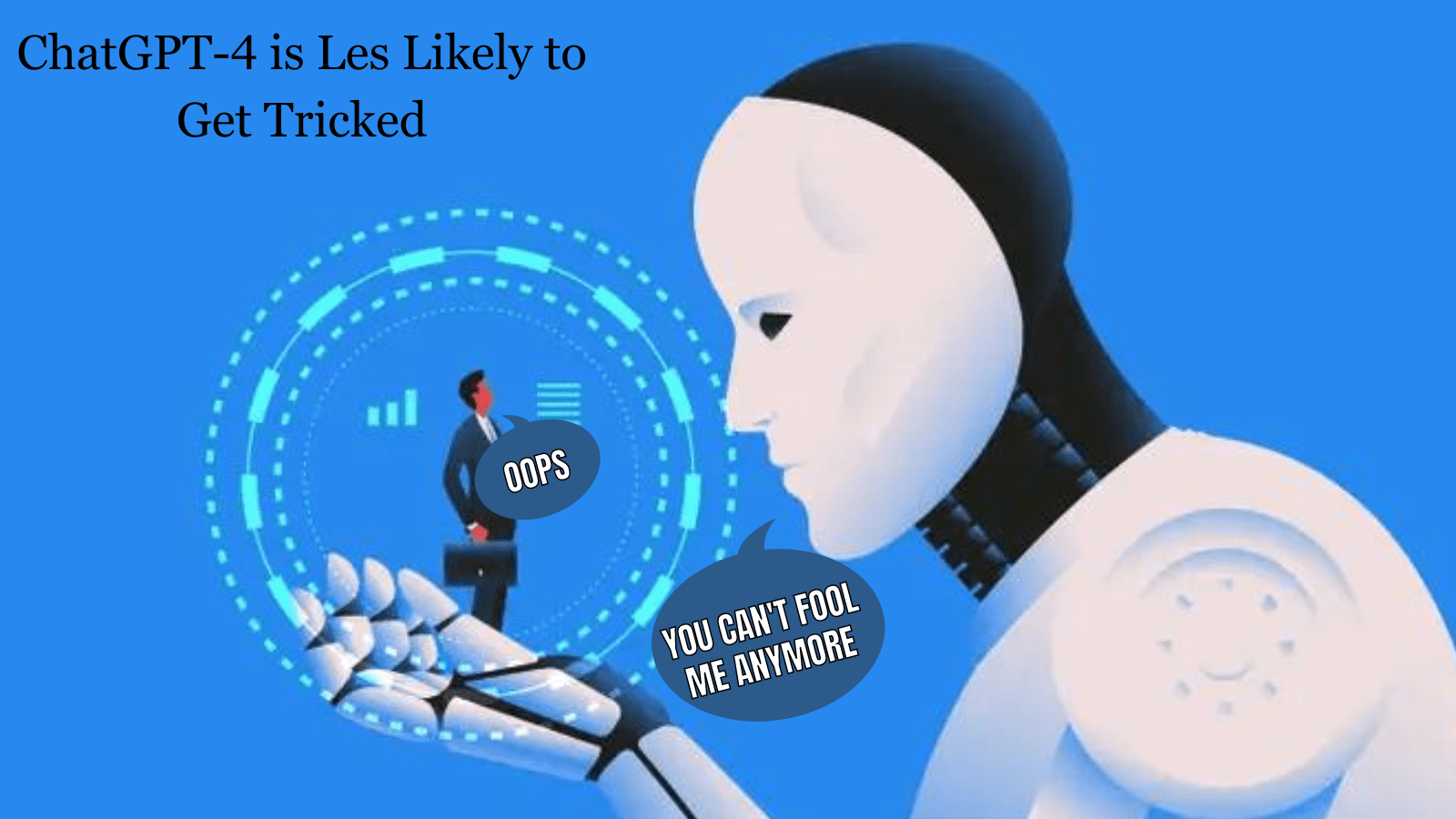
4 – Safe Responses
GPT-4 is a significant upgrade from the GPT-3.5 model in terms of safety measures. OpenAI has worked for over six months to ensure that GPT-4 is safer by incorporating safety measures at the model level. According to GPT-4 Technical Report, it produces toxic responses only 0.73% of the time compared to GPT-3.5’s 6.48% of toxic replies.
While OpenAI claims that its safety testing has been sufficient for GPT-4 to be used in third-party apps, the company acknowledges that safety is a process and that surprises may occur. GPT-4 generates safer and more insightful responses, making it a promising tool for applications that rely on AI-generated information.
5 – More Languages
While the AI industry is largely dominated by English speakers, GPT-4 has shown that it can accurately answer multiple-choice questions in 26 different languages, from Spanish to Mandarin to Hindi. Although it performs best in Romance and Germanic languages, it still generates decent sentences in other languages. This preliminary testing of GPT-4’s multilingual capabilities is promising, but it is not a full embrace of such capabilities. However, this demonstrates the possibility of GPT-4 being more accessible to non-English speakers.
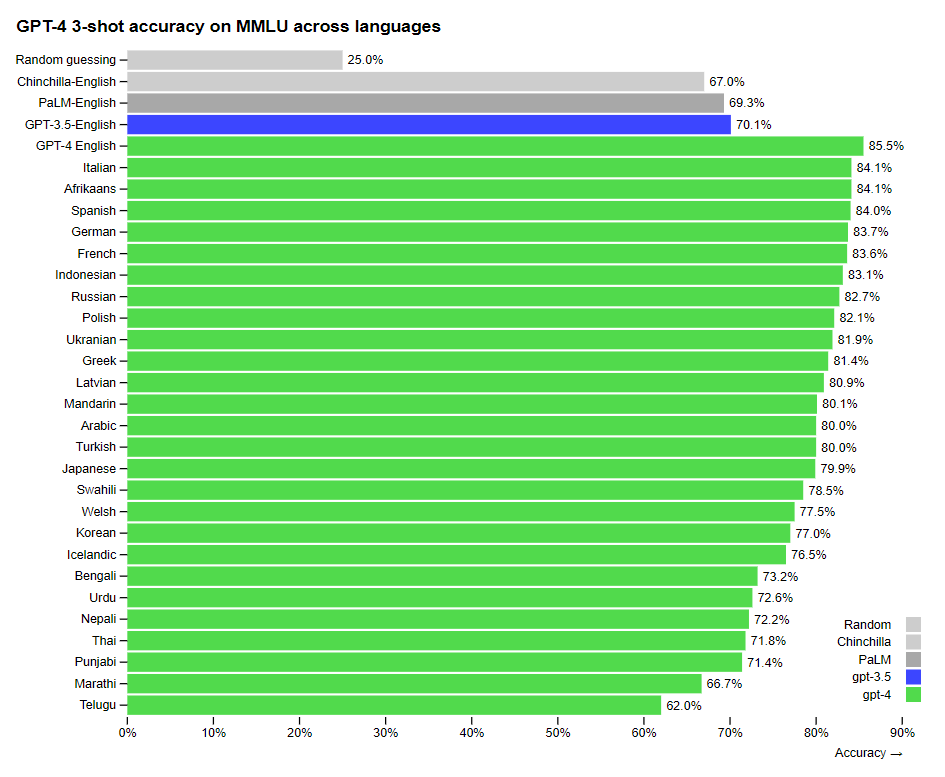
6 – Longer Memory / Context Window
GPT-4 claims a significant improvement in its context window and memory size over its predecessor model, GPT-3.5. A context window refers to how much data the model can retain in its memory during a chat session and for how long. With GPT-4, it can remember the context of a conversation for longer, as well as the instructions given during the conversation.
In contrast, GPT-3.5 often failed to follow instructions or went off-topic as the conversation progressed. This issue still exists with GPT-4, but it is less of a problem due to its improved context window.
While GPT-3.5 had a token count limit of 4,096, GPT-4 has a maximum token count of 32,768, equivalent to 50 pages of text or 64,000 words. The expanded memory capabilities of GPT-4 allow it to better retain and recall information from conversations or generate more complex and refined writing.
7 – Different Personalities
GPT-4 offers users the ability to customize the classic ChatGPT personality, with a fixed verbosity, tone, and style. This feature, known as steerability, allows the model to change its behavior on demand.
While steerability can be useful in certain situations, it can also be dangerous if users convince the model that it is evil or depressed. GPT-4 incorporates steerability more natively than its predecessor, GPT-3.5, making it easier for users to change the model’s personality within certain bounds.
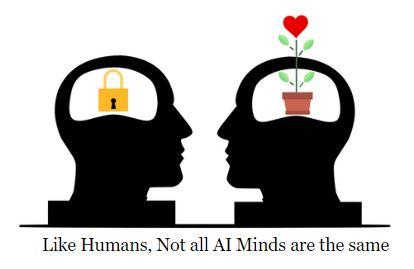
8 – Creativity and Complexity
GPT-4 provides more creative responses to prompts than GPT-3.5. The difference becomes apparent in more challenging tasks like writing a poem in multiple languages. Chat GPT can collaborate and generate writing projects for creative and technical purposes, acting as an expert advisor. These AI tools are surpassing human brains in terms of processing speed, memory size, and artistic creativity. The model is “more creative and collaborative than ever before.”
9 – Can Handle Multiple Tasks
GPT-4 can handle multiple tasks simultaneously, which can speed up processes for businesses. It outperforms GPT-3 by up to 16% on common machine learning benchmarks and can take on multilingual tasks more efficiently.
10 – Input & Output Word Limit
GPT-4 can process up to 25,000 words at once, which is 8 times more than GPT-3, making it better equipped to handle larger documents. GPT-3.5, on the other hand, is limited to approximately 3,000-word responses, making GPT-4 a more efficient tool in certain work environments.
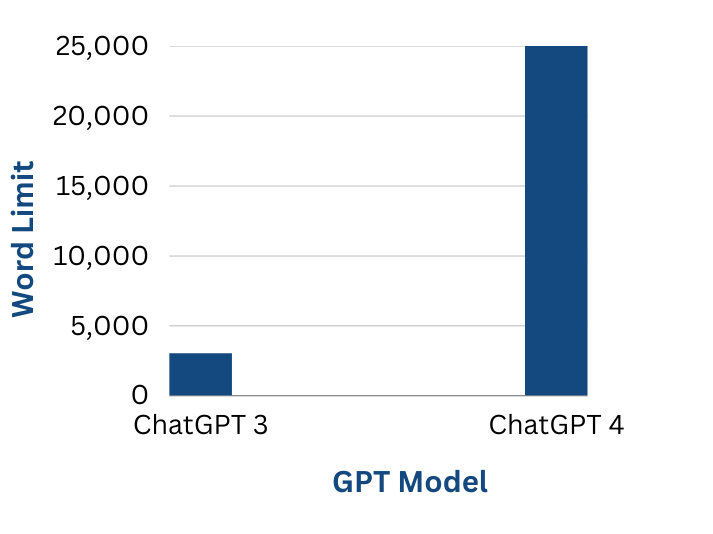
How to Use GPT-4?
Want to experience the capabilities of GPT-4? You can access it through OpenAi’s ChatGPT Plus, which costs $20 a month and is available to the general public. GPT-4 is also accessible to developers through its API. Upgrading to ChatGPT Plus gives you quicker response times, priority access to new features, and more frequent updates. With a limited, text-only capacity, GPT-4 is also available to users who sign up for the waitlist.
And if you’d like to experiment with the GPT-4 version for free, then the best way would be to sign up for Microsoft’s Bing and use the chat mode.
GPT-4 on ChatGPT Plus: Is the Subscription Worth the Cost?
Subscribing to ChatGPT Plus and gaining access to GPT-4 can be worth the cost for those who require highly accurate and advanced outputs, especially in professional or important settings where mistakes cannot be afforded. However, for the regular user, it may not yet be worth the investment as the responses from GPT-3.5 and GPT-4 are not noticeably different and the image analysis capabilities are not yet available.
Additionally, the number of allowed prompts per day may vary and the model can be slower to respond compared to GPT-3.5. Ultimately, it depends on the individual’s needs and budget.
Read More: 12 Major Differences Between ChatGPT And Google Bard
Conclusion
After analyzing the data, it’s safe to say that ChatGPT Plus with access to GPT-4 has its pros and cons. On one hand, it boasts impressive stats and improvements compared to GPT-3.5, such as higher scores on standardized exams and increased accuracy. On the other hand, there are limitations to the number of prompts allowed, longer response times, and a lack of transparency regarding the model’s details.
For individuals who require advanced-level output or work in important places where accuracy is crucial, ChatGPT Plus may be a worthwhile investment. However, for regular folks, the subscription may not be worth the cost just yet, especially considering the limited access to image-analysis capabilities.
Overall, it’s important to weigh the benefits and drawbacks before deciding whether or not to subscribe to ChatGPT Plus. As with any technology, there are trade-offs to consider. As we await the release of the visual input capabilities, it will be interesting to see how the model evolves and what other features and improvements may be in store.
Frequently Asked Questions (FAQs)
Is it possible for GPT-4 to generate computer code?
Yes, GPT-4 can generate computer code in various programming languages such as JavaScript, Python, and C++. Its impressive ability to produce human-like text, images, and code from a given prompt has stunned people, with some even successfully creating functional websites.
How many parameters does GPT-4 have?
Though OpenAI has not disclosed the exact specifications of GPT-4’s parameters, it has been speculated to have more than 1 trillion parameters, surpassing GPT-3’s 175 billion parameters. While rumors suggested that GPT-4 may have had 100 trillion parameters, OpenAI CEO Sam Altman denied them. The focus for GPT-4 will likely be on improving the chatbot’s performance rather than on an increase in parameter size.
When was ChatGPT 4 released?
ChatGPT 4 was released on March 14, 2023.
Who has access to ChatGPT 4?
Only ChatGPT Plus subscribers and software developers with a waitlist have access to GPT-4’s text-input feature. The image-input ability is not publicly available yet.
What is new in ChatGPT 4?
ChatGPT-4 is the latest version of OpenAI’s language model, with new features aimed at improving its accuracy, safety, and versatility. One of the most notable updates is its ability to handle multimodal inputs, including images, and generate captions or responses based on visual content. GPT-4 also boasts better alignment, factuality, and style control, allowing developers to fine-tune their AI models’ tone and verbosity to match user needs.

